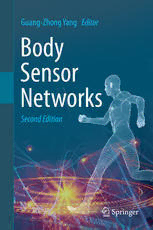Table Of ContentGuang-Zhong Yang Editor
Body
Sensor
Networks
Second Edition
Body Sensor Networks
Guang-Zhong Yang, PhD
Editor
Body Sensor Networks
Second Edition
Editor
Guang-ZhongYang,PhD
DirectorandCo-Founder,TheHamlynCentre
ImperialCollegeLondon
London,UK
ISBN978-1-4471-6373-2 ISBN978-1-4471-6374-9(eBook)
DOI10.1007/978-1-4471-6374-9
SpringerLondonHeidelbergNewYorkDordrecht
LibraryofCongressControlNumber:2014937397
©Springer-VerlagLondon2006,2014
Thisworkissubjecttocopyright.AllrightsarereservedbythePublisher,whetherthewholeorpart
of the material is concerned, specifically the rights of translation, reprinting, reuse of illustrations,
recitation,broadcasting,reproductiononmicrofilmsorinanyotherphysicalway,andtransmissionor
informationstorageandretrieval,electronicadaptation,computersoftware,orbysimilarordissimilar
methodologynowknownorhereafterdeveloped.Exemptedfromthislegalreservationarebriefexcerpts
inconnectionwithreviewsorscholarlyanalysisormaterialsuppliedspecificallyforthepurposeofbeing
enteredandexecutedonacomputersystem,forexclusiveusebythepurchaserofthework.Duplication
ofthispublicationorpartsthereofispermittedonlyundertheprovisionsoftheCopyrightLawofthe
Publisher’s location, in its current version, and permission for use must always be obtained from
Springer.PermissionsforusemaybeobtainedthroughRightsLinkattheCopyrightClearanceCenter.
ViolationsareliabletoprosecutionundertherespectiveCopyrightLaw.
The use of general descriptive names, registered names, trademarks, service marks, etc. in this
publicationdoesnotimply,evenintheabsenceofaspecificstatement,thatsuchnamesareexempt
fromtherelevantprotectivelawsandregulationsandthereforefreeforgeneraluse.
While the advice and information in this book are believed to be true and accurate at the date of
publication,neithertheauthorsnortheeditorsnorthepublishercanacceptanylegalresponsibilityfor
anyerrorsoromissionsthatmaybemade.Thepublishermakesnowarranty,expressorimplied,with
respecttothematerialcontainedherein.
Printedonacid-freepaper
SpringerispartofSpringerScience+BusinessMedia(www.springer.com)
Preface
Usebodyasthemedium,inspirationandasourceofenergytoprovidecontinuoussensing,
monitoringandintervention
Since the first edition of this book, the field of Body Sensor Networks (BSNs)
has advanced rapidly. The original motivation of BSN was to harness allied
technologies that underpin the development of pervasive sensing for healthcare,
wellbeing,sportsandotherapplicationsthatrequire“ubiquitous”and“pervasive”
monitoringofphysical,physiological,andbiochemicalparametersinanyenviron-
ment without activity restriction and behaviour modification. The ultimate aim of
BSN is therefore to provide a truly personalised monitoring platform that is
pervasive,intelligentandcontext-aware,yet“invisible”,withapplicationsranging
from managing patients with chronic disease and care for the elderly, to general
well-being monitoring and performance evaluation in sports. To ensure its wide-
spread use, there are many technical challenges that need to be tackled. These
include the need for better sensor design, MEMS integration, biocompatibility,
powersourceminiaturisation,lowpowerwirelesstransmission,contextawareness,
securedatatransferandintegrationwithsmarttherapeuticsystems.
Inthissecondeditionofthebook,wehaveupdatedthechapterswiththelatest
developments in the field, addressing sensor design, micro-electronics and infor-
mation processing aspects of the system. Since its inception, the development of
BSNhasbeenfocussedonbothwearableandimplantablesensors.Inthelastfew
decades, we have seen rapid advances in both chemical and biosensor develop-
ments. The emergence of new biological sensing modalities is fundamentally
changing the way we apply biomeasurements in vivo. In terms of implantable
sensing,manyoftheissuesassociatedwiththeextensionofbiosensortechnology
frominvitro toinvivoapplications have long been appreciated, andanumber of
practical issues are addressed in this book. In a BSN with limited bandwidth and
power constraints, the conventional method of data acquisition and analogue-to-
digitaldataconversionwithsignalprocessingtakingplaceaftertransmissionisno
longer optimal. A BSN represents a prime candidate for bio-inspired local
processingtotakeplaceatthesensorfront-endbeforetransmission.Thisprocessing
v
vi Preface
couldincludespatialandtemporalaveragingfordriftandfailuretolerance.Thekey
principle of bio-inspired engineering in this application area is that biology does
notoftendealinabsolutevalues,butinrelativechangesfromagivennorm.
Fromasensordataprocessingandinferencingpointofview,thedevelopmentof
the BSN has introduced a whole range of challenging research issues in pattern
recognition, behaviour profiling and machine learning. The pursuit of low-power,
miniaturised, smart sensing embodied either as a wearable or implantable device
has also imposed significant challenges on integrating information from what is
often heterogeneous, incomplete and error-prone sensor data. In practice, it is
therefore desirable to rely on sensors with redundant or complementary data to
maximisetheinformationcontentandreducebothsystematicandrandomerrors.
One important aspect of the book is the introduction of bio-inspired concepts
bothforhardwaredesignandfordevelopingsoftwarecomponentsthatpossessthe
self-* properties of autonomic sensing. We have discussed the use of artificial
neural networks for performing context-aware sensing, and the use of autonomic
principles of self-healing, self-organisation and self-protection for developing
BSNswitheffectivefaulttoleranceandself-protection.
Asmentionedinthefirsteditionofthisbook,advancesinscienceandmedicine
are intimately linked. In current clinical practice, ranging from prevention to
complex intervention, we rely heavily on early, accurate and complete diagnosis
followed by close monitoring of the results. Attempts so far, however, are still
limited to a series of snapshots of physiological, biomechanical and biochemical
data. Transient abnormalities cannot always be reliably captured. The concept of
BSN is therefore an important ingredient for the future development of pervasive
healthcarebecausetechnologicaldevelopmentsinsensingandmonitoringdevices
willnotonlychangechronicdiseasemanagementinahomeorcommunitysetting,
butalsoreshapethegeneralpracticeofclinicalmedicine.
Withdemographicchangesassociatedwiththeagingpopulationandtheincreas-
ingnumberofpeoplelivingalone,thesocialandeconomicstructureofoursociety
is also changing rapidly. In a population consisting of several vulnerable groups,
such as those with chronic disease and the elderly, the need for effective
individualised health monitoring and delivery is the primary motivation for the
developmentofBSNs.ThereislittledoubtthatforthedevelopmentoftheBSN,a
panoply of technologies will need to be combined in new and previously
unsuspected ways. However, the rewards for success, in terms of the quality and
durationoflifeinthecaseofmanyofthosesufferingfromchronicconditions,will
besubstantial.
There has been tremendous effort from all contributors of this book in making
this 2nd edition possible. I would like to express my sincere thanks to all the
contributingauthors.Withouttheirenthusiasm,support,andflexibilityinmanaging
the tight publishing schedule, this book would not have become possible. In
particular, I would like to thank Su-Lin Lee, Emily Yang, Benny Lo, and Surapa
Thiemjarus, for all their hard work in providing essential editorial support, as
wellasbeingactivelyinvolvedinthepreparationofsomeofthetechnicalchapters.
I would also like to thank the editorial staff of Springer, the publisher of
Preface vii
this volume. In particular, I am grateful to Helen Desmond and her colleagues in
helpingwiththeeditorialmatters.
This work would not have been possible withoutthe financial support from all
the funding bodies that supported our work, particularly the Engineering and
Physical Sciences Research Council (EPSRC), UK. Their generous support has
allowedustoestablishandpromotethisexcitingfieldofresearch–atopicthatisso
diversified, and yet brings so many challenges and innovations to each of the
disciplinesinvolved.
I do hope this book will act as a valuable resource to a very wide spectrum of
readersinterestedin,orinspiredby,thismultifacetedandexcitingtopic.
London Guang-ZhongYang
November2013
About the Editor
Guang-Zhong Yang (PhD, FREng) is Director and Co-founder of the Hamlyn
Centre, Deputy Chairman of the Institute of Global Health Innovation, Imperial
College London, UK. Professor Yang also holds a number of key academic
positions at Imperial College – he is Director and Founder of the Royal Society/
Wolfson Medical Image Computing Laboratory, co-founder of the Wolfson
Surgical Technology Laboratory, Chairman of the Centre for Pervasive Sensing.
He is a Fellow of the Royal Academy of Engineering (RAEng), fellow of IEEE,
IET, MICCAI, AIMBE, IAMBE, City of Guilds and a recipient of the Royal
SocietyResearchMeritAwardandTheTimesEureka‘Top100’inBritishScience.
Professor Yang’s main research interests are in medical imaging, sensing and
robotics. In imaging, he is credited for a number of novel MR phase contrast
velocity imaging and computational modelling techniques that have transformed
invivobloodflowquantificationandvisualization.Theseincludethedevelopment
oflocallyfocusedimagingcombinedwithreal-timenavigatorechoesforresolving
respiratory motion for high-resolution coronary-angiography, as well as MR
dynamic flow pressure mapping for which he received the ISMRM I. I. Rabi
Award. He pioneered the concept of perceptual docking for robotic control,
whichrepresentsaparadigmshiftoflearningandknowledgeacquisitionofmotor
andperceptual/cognitivebehaviourforrobotics,aswellasthefieldofBodySensor
Network(BSN)forprovidingpersonalizedwirelessmonitoringplatformsthatare
pervasive, intelligent, and context-aware. Professor Yang is a Distinguished Lec-
turerfor IEEEEngineering inMedicineandBiologySocietyandEditor-in-Chief,
IEEEJournalofBiomedicalandHealthInformatics.
ix

